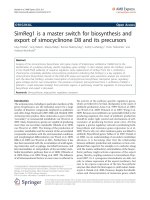Saponaria bargyliana gombault (Caryophyllaceae): A new record for Turkey and analysis of its morphological characters with related species
Bạn đang xem bản rút gọn của tài liệu. Xem và tải ngay bản đầy đủ của tài liệu tại đây (415.13 KB, 8 trang )
Turk J Bot
30 (2006) 63-70
â TĩBTAK
Research Article
Saponaria bargyliana Gombault (Caryophyllaceae): A New Record
for Turkey and Analysis of Its Morphological Characters with
Related Species
Birol MUTLU*
nửnỹ University, Faculty of Science and Arts, Department of Biology, 44280 Malatya - TURKEY
Received: 18.10.2004
Accepted: 05.12.2005
Abstract: Previously, Saponaria bargyliana Gombault was known only from its type locality, the north of Syria in the Nosaùris
mountains, which was published by Gombault in 1962. During a field trip in June 2002 to Erzin (Hatay) district, the species was
collected for the second time from a new locality far from its locus classicus. Thus, this species was described as a new record for
the flora of Turkey. The description of this species was expanded and its geographical distribution, habitat, flowering time and
conservation status are discussed. Quantitative and qualitative analysis of Saponaria bargyliana and closely related species is
discussed. Eleven quantitative characters were used in a linear discriminant analysis. In the discriminant analysis, the most useful
characters for separating particular species were selected: seed number, calyx nerve number, coronal scale length, calyx teeth length
and petal width. With these 5 most important characters, 100% of plants were correctly classified into the designated groups. The
analysis showed that S. bargyliana, S. officinalis L. and S. glutinosa M.Bieb. are distinguished by the quantitative morphological
characters. Calyx hair arrangement and the condition of the pedicel hairs are the most important qualitative characters in the
identification of these species.
Key Words: Caryophyllaceae, Saponaria, new record, morphology, linear discriminant analysis
Saponaria bargyliana Gombault (Caryophyllaceae): Tỹrkiye ỗin Yeni Bir Kayt ve Yakn Tỹrler
ile Birlikte Morfolojik Karakter Analizi
ệzet: Bu zamana kadar, 1962 ylnda Gombault tarafndan yaynlanan Saponaria bargyliana Gombault sadece tip lokalitesi olan
Suriyenin kuzeyindeki Nosaùris daÔndan bilinmekteydi. Erzin (Hatay) bửlgesinde Haziran 2002de yaplan bir arazi ỗalflmasnda tip
lokalitesinden oldukỗa uzak bir bửlgeden ikinci kez topland. Bửylece bu tỹr Tỹrkiye floras iỗin yeni bir kayt olarak belirlendi. Tỹrỹn
tanm geniflletildi, coÔrafik daÔlm, habitat, ỗiỗeklenme zaman ve tehlike durumu tartflld. Saponaria bargyliana ve yakn tỹrlerinin
nicel ve nitel morfolojik karakterlerinin analizi yapld. 11 nicel karakter doÔrusal ayrflm analizinde kullanld. Ayrflm analizinde
tỹrleri birbirinden ayran en uygun karakterlerin; tohum says, ỗanakyapraÔ damar says, korollapulu boyu, taỗyapraÔ geniflliÔi ve
ỗanakyapraÔ difl boyu olduÔu belirlendi. Ayrflm analizi snflamasnda en ửnemli befl karakter bitkilerin tamamn tasarlanan
gruplara doÔru bir flekilde snflamfltr. Bu analiz, S. bargyliana, S. officinalis L. ve S. glutinosa M.Biebnin nicel morfolojik karakterler
ile ayrlabileceÔini gửstermektedir. ầanakyapraÔ tỹy dỹzenlenmesi ve ỗiỗek sap tỹy durumu bu tỹrlerin tanmlanmasnda en ửnemli
nitel karakterlerdir.
Anahtar Sửzcỹkler: Caryophyllaceae, Saponaria, yeni kayt, morfoloji, doÔrusal ayrflm analizi
Introduction
The author carried out extensive field studies in
South-East Anatolia and collected some Caryophyllaceae
specimens from the area in 2002. At first glance in the
field, one of them looked like Saponaria officinalis L. and
S. glutinosa M.Bieb. because of the habit and stem leaf.
After closer examination and consultation with the
Flora of Turkey and the East Aegean Islands (Hedge,
1965; Davis et al., 1988) it was realised that the
specimens were quite different from Saponaria officinalis
and S. glutinosa. The specimens were crosschecked with
various Saponaria accounts given in relevant floras, e.g.,
* E-mail:
63
Saponaria bargyliana Gombault (Caryophyllaceae): A New Record for Turkey and Analysis of Its Morphological Characters with Related Species
Flora Iranica (Rechinger, 1988), Flora Europaea (Chater,
1964), Flora Palaestina (Zohary, 1966), Flora of Syria,
Palestine and Sinai (Post, 1932), Flora of USSR
(Komarov, 1939) and Flora of Cyprus (Meikle, 1977).
As a result of further comparative studies and
discussion (Pers. com. with Mr. I. Hedge), I determined
that this specimen was similar to S. bargyliana Gamboldt.
This species was collected in the north of Syria in the
Nosaïris mountains and only published in Bulletin Societe
Botanique de France, 1962 and the type specimen is
found in Paris Natural Museum Herbaria (P). After I had
studied the type specimen (Gamboult, 1962), I decided
that this specimen is S. bargyliana and thus a new record
for the Flora of Turkey.
At the same time, the purpose of this study was to
analyse quantitative characters in order to answer the
following questions: (1) Is it possible to recognise
particular taxa using quantitative characters? (2) Which
quantitative characters are most useful for species
identification?
Materials and Methods
The measurements were obtained from either
specimens collected in the field or kept in ANK, GAZI and
HUB herbaria in Turkey and Paris Natural Museum
Herbarium (P) in France. The total number of herbarium
specimens analysed in the morphometric multivariate
analysis is 41 (Appendix 1). Qualitative characters were
chosen from among those used in the most recent
taxonomic revision of Saponaria (Hedge, 1965) and some
of them were used in this study for the first time.
Authorities of all cited plant names are given according to
Brummitt and Powell (1992).
I tested the utility of 11 characters, including 9
measurements and 2 meristics (of these, 3 were
vegetative and 8 were floral), for separating the 3 species
using multivariate analysis of variance (MANOVA) in SPSS
(Statistical Package for the Social Sciences) (SPSS, 1999).
Discriminant analysis was chosen to determine the
suitability of specific variables for predictive classification.
Linear discriminant analysis (LDA) was selected because it
requires the assumption of equal covariance matrices
(Özdamar, 2002). The DISCRIMINANT subprogram of
SPSS was used for this analysis. The canonical
discriminant analysis was computed using the program.
First, the entire data set was analysed, and then
64
taxonomically indistinct species pairs were analysed
separately. Characters with the highest coefficient of the
canonical structure on the 2 canonical functions were
selected. These characters explain the highest proportion
of variance between groups (species). Then stepwise
discriminant analysis was used to find the best set of
discriminate characters. In this analysis, characters were
entered one by one and the process stopped when none
of the remaining characters significantly improved the
discriminant capacity (P < 0.01).
Finally, a classification discriminant analysis (crossvalidation) of the samples with the classification function
combining respective characters and their weights was
carried out to determine the group (taxon) into which the
classified object belongs with the highest probability.
Results and Discussion
S. officinalis is very widespread in North Anatolia. S.
glutinosa is spread in North Anatolia, between West and
Inner Anatolia and the Anatolian Diagonal. S. bargyliana
only grows on the north side of Amanos Mountain,
southern Anatolia, Hatay. This mountain is remarkable
for its numerous Euro-Siberian elements, which have
reached it from the north, probably by migration down
the Anatolian Diagonal during the glacial (pluvial) phase of
the Pleistocene. Because of this reason, it supports
numerous endemics and subendemics (Davis, 1971).
S. bargyliana grows in mixed forest where Fagus
orientalis Lipsky is the dominant tree. Pinus brutia Ten.,
Carpinus orientalis Miller, and Quercus cerris L. var. cerris
are other common trees in this area at 1500-1900 m.
The range of this new species is restricted to only one
location.
Saponaria bargyliana Gombault in Bulletin Société
Botanique de France, 109:265 (1962) (Figure 1).
Type: North Syria: Espèce découverte en juillet 1934
et 1938 per le Frère LOUIS qui l’a récoltée à Slenfé et au
col de Freiket dans les Monts Nosaïris (Bargylus mons de
Pline) (P)!
Iconography: This species is illustrated in this article
for the first time (Figure 1).
Description: Erect perennial, glandular-hispid
throughout. Stem 30-60 cm, simple or little branched,
hairy, all hairs multicellular glandular-hispid, up to 1-1.5
mm. Leaves oblong-elliptic, (15-) 25-75 x (6-) 12-25
B. MUTLU
B
C
1 cm
1 cm
1 cm
A
5 mm
D
E
1 mm
F
Figure 1. Saponaria bargyliana (A) habit; (B) flower; (C) dissected calyx; (D) petal; (E) fruit; (F) hairs.
mm, acute or acuminate, shortly petiolate at the base or
sessile at the upper side, distinctly 3 nerved, glabrous on
the upper side and pubescent on the under side.
Inflorescence compact, terminal corymbose-paniculate,
shortly pedunculate, 12-42 flowered with an
indumentum of long glandular hairs. Bracts herbaceous,
3 nerved, lanceolate-triangular, 3-12 x 1-3 mm, long
eglandular hairy, ciliate margin. Pedicel glabrous, 0.5-1
mm. Calyx green or yellowish green, glandular, hairs only
arrangement on the nerves, narrowly oblong-cylindrical,
calyx length 12-21 mm, dissected calyx width 5-6 mm,
15 nerves, teeth ovate, acuminate, 4-5.5 mm. Petals
pink, 20- 25 x 3-3.5 mm, obovate lamina with 2 small
scales at the base and a narrow claw, scale subulate, 1.52 mm. Capsule oblong-ovate, subsesile shorter than
calyx. Seed 8-12.
Flowering time: S. bargyliana is known to flower in
May, June and July.
Distribution and habitat: Turkey/C6 HATAY: Erzin, 30
km from Kuzuculu Village towards Ufacık area, 12001350 m, 17/6/2002, F. orientalis-C. orientalis mixed
forest, B. Mutlu 8034. (Figure 2).
Conservation status: Its distribution area is less than
10 km2 and it is known from only one location (criterion
B2) in Turkey. This species should be considered
65
Saponaria bargyliana Gombault (Caryophyllaceae): A New Record for Turkey and Analysis of Its Morphological Characters with Related Species
1
2
3
4
5
6
7
8
9
42
Edirne
Sinop
‹stanbul
Artvin
A
Trabzon
Ankara
40
Erzurum
Çanakkale
B
‹zmir
Malatya
Van
38
Konya
Antalya
C
Hatay
26
28
30
32
34
36
38
0
100 200 km
40
42
44
36
Figure 2. Distribution of Saponaria bargyliana (•) in Turkey.
“critically endangered (CR)” according to the new IUCN
categories (IUCN, 2001).
Character analysis: S. bargyliana, S. officinalis and S.
glutinosa are more closely related to each other than the
remaining species. The MANOVA demonstrated that 8
characters varied significantly among the 3 species (P <
0.01). All of these characters are floral. These characters
are given in Table 1 in bold. Multivariate statistical
analysis indicated that the 3 species differed significantly
with respect to their morphologies (Wilks’ lambda:
0.001; F: 88.842; df: 22; P < 0.001).
The quantitative characters of these species are given
in Table 1 and qualitative characters are given in Table 5.
The correlations between quantitative characters were
tested using the Pearson test (Table 2). High correlations
were found for the character pair’s sen and cxnn (0.850,
P < 0.01), and cxnn and cxtl (0.832, P < 0.01). Sen, cxw
and pel are correlated with other 6 characters significant
at the 0.01 and 1 character significant at the 0.05 levels
(Table 2). For this reason, sen, cxw and pel are the most
important characters for the discrimination of these
species.
Table 1. List of the quantitative characters and results of measurements. Statistical significant (P < 0.001)
characters shown in bold.
66
S. bargyliana
S. officinalis
S. glutinosa
12-21
18-25
18-28
5-6
8-16
6.5-11
4-5
1.5-3
4-6
15
24-33
15-24
17-25
25-36
14-17
Acronym
Character
CXL
calyx length (mm)
CXW
dissected calyx width (mm)
CXTL
calyx teeth length (mm)
CXNN
number of calyx nerve
PEL
petal length (mm)
PEW
petal width (mm)
2.5-4
4-7
0.5-2
COSL
coronal scale length (mm)
1-2
1-2
0.5-1.5
SEN
seed number
8-12
52-80
20-30
LEL
middle stem leaf length (mm)
4-7
5-10
4.5-8.1
LEW
middle stem leaf width (mm)
1.3-2.5
1.1-2.3
1.3-3.7
LEL/ LEW
ratio of leaf length to leaf width (mm)
2.5-4.8
2.9-5.1
1.8-6.2
B. MUTLU
Table 2. Pearson correlation coefficients between quantitative characters and species (groups) discriminate ratio of character pairs.
C o r r e l a t i o n
Discriminate ratio (%)
CXL
CXW
CXTL
CXNN
PEL
PEW
COSL
SEN
LEL
CXL
-
92.7
97.6
95.1
95.1
97.6
87.8
80.5
80.5
80.5
CXW
0.378*
-
95.1
92.7
87.8
100
85.4
100
85.4
87.8
85.4
CXTL
0.327*
-0.529**
-
87.8
75.6
100
92.7
97.6
75.6
80.5
82.9
CXNN
-0.005
0.691**
-0.832**
-
80.5
97.6
90.2
100
80.5
80.5
73.2
PEL
0.198
0.757**
-0.650**
0.747**
-
97.6
85.4
100
70.7
70.7
70.7
PEW
-0.387*
0.499**
-0.822**
0.765**
0.702**
-
95.1
100
97.6
97.6
97.6
COSL
-0.409**
-0.244
-0.146
-0.100
0.054
0.344*
-
100
61.0
53.7
63.4
SEN
0.120
0.766**
-0.805**
0.850**
0.805**
0.730**
.039
-
100
97.6
100
LEL
0.192
0.401**
-0.266
0.358*
0.422**
0.236
-.057
0.344*
-
46.3
48.8
LEW
0.152
0.037
0.262
-0.228
-0.064
-0.222
-0.181
-0.193
0.259
-
46.3
lel/lew
0.091
0.233
-0.328*
0.391*
0.325*
0.267
0.121
0.401**
0.470**
-0.681**
-
97.6
LEW
lel/lew
* P< 0.05; ** P< 0.01
The uncorrelated characters useful for distinguishing
between particular taxonomically complicated species
pairs were also selected by this method. Saponaria species
were 100% classified by characters of sen. Other
characters were not fully classified, but only pew-cxtl and
pew-cxw character pairs classified samples of these
species 100%. Lel-lew and lew-lel/lew character pairs
separated the least samples of these species (Table 2).
Pew (S. bargyliana-S. glutinosa and S. officinalis-S.
glutinosa), cxtl (S. bargyliana-S. officinalis and S.
officinalis-S. glutinosa) and cxnn (S. bargyliana-S.
10
8
6
2 nd Discriminant function
Linear discriminant analysis was successful in
grouping species (Figure 3). Figure 3 shows samples of
Saponaria species arranged in the 2-dimensional space.
Stepwise discriminant analysis, run in 22 steps, selected
5 uncorrelated characters for distinguishing between
Saponaria species. These 5 characters were used in the
classification discriminant analysis that classified 100% of
the samples to the designated assumed groups. The
standardised coefficients of the canonical functions are
given in Table 3. The largest absolute correlation between
each variable and any discriminant function are given in
bold in this table. The first discriminant function is most
highly correlated with sen, cxnn and cxtl while the second
is with pew and cosl. The scatterplot of specimens against
2 functions provides good discrimination for S.
bargyliana, S. officinalis and S. glutinosa. The first 2
discriminant functions together explain 100% of
variance. In the analysis of the entire data set, the 2
canonical functions accounted for 100% of currently
classified individuals (Table 4).
4
2
0
-2
-4
-6
-8
-10
-20
-10
0
10
20
1 st Discriminant function
Figure 3. Discriminant scores for individuals of Saponaria bargyliana
(▼), S. officinalis (*); S. glutinosa (+), and the scores of all
individuals are projected onto the 2-dimensional space
defined by first and second discriminant functions. The black
point symbols are the unstandardised canonical discriminant
functions evaluated at the group means (centroids).
67
Saponaria bargyliana Gombault (Caryophyllaceae): A New Record for Turkey and Analysis of Its Morphological Characters with Related Species
Table 3. The standardised coefficients for 2 discriminate functions, the Eigenvalue, cumulative
percent of the total variance accounted for, and the canonical correlation from analysis
of quantitative characters. Largest absolute correlation between each variable in any
discriminate functions are shown in bold. See text for details and Table 1 for
abbreviations of characters. (a): this variable not used in the analysis.
Function
No.
Character
1
2
1
SEN
0.530
0.211
2
CXNN
0.310
0.052
3
LELa
-0.304
-0.163
4
CXTL
-0.296
0.199
5
a
CXL
-0.035
0.026
6
PEW
0.410
-0.561
7
LEWa
-0.162
-0.337
8
PELa
0.227
-0.305
9
a
LEL/LEW
10
COSL
11
CXWa
-0.087
0.305
0.006
-0.289
-0.043
-0.155
72.080
16.638
Cumulative %
81.2
100.0
Canonical correlation
0.993
0.971
Eigenvalue
Table 4. Results of classification discriminant analysis (cross-validation): 1-S. bargyliana, 2S. officinalis, and 3-S. glutinosa.
Predicted group membership
1
Actual group
3
% Correctly
classified
100
1
10
0
0
2
0
13
0
100
3
0
0
18
100
officinalis) characters classify 100% of the species pairs
in parentheses.
Leaf shape (oblong-elliptic), leaf nerve number
(distinctly 3 numbers), petiole condition (petiolate or
sessile) and stem length (25-70 cm) as vegetative
characters of these species are similar. S. bargyliana
differs from S. officinalis because it has a thick and
cylindrical root (not creeping rhizome); calyx teeth shape
lanceolate-acuminate (not ovate-acuminate); upper shape
of petal entire (not entire or slightly retuse); coronal scale
68
2
shape subulate (not lanceolate); it differs from S.
glutinosa because it is perennial (not biennial); calyx hairs
monotypic only long (not long and short); upper shape of
petal entire (not bifid). Calyx hair arrangement and
pedicel hair condition are good taxonomical qualitative
characters which distinguished S. bargyliana from S.
officinalis and S. glutinosa. Calyx hairs are only on the
calyx nerve in S. bargyliana but in S. officinalis and S.
glutinosa hairs covered the entire outer surface of the
calyx. Pedicels of S. bargyliana are glabrous, but pedicels
of other Saponaria species are hairy (Table 5).
B. MUTLU
Table 5. A comparison of qualitative characters in S. bargyliana and the most similar taxa, S. officinalis and S. glutinosa.
Characters
S. bargyliana
S. officinalis
S. glutinosa
Root
perennial, thick and cylindrical
perennial with a creeping rhizome
biennial, thick and cylindrical
Pedicel hairs
glabrous
hairy
hairy
Petal colours
dark pink, purple or rose
white or pink
dark pink
Calyx teeth shape
lanceolate-acuminate
ovate-acuminate
lanceolate-acuminate
Calyx hairs arrangements
on the nerves
throughout
throughout
Calyx hairs shape
long
short
long and short
Upper shape of petal
entire
entire or slightly retuse
bifid
Coronal scale shape
subulate
lanceolate
subulate
The genus Saponaria L. was first revised by Hedge
(1965) in Flora of Turkey and the East Aegean Islands.
Since the first revision, a new taxon has been described
from Turkey, S. pinetorum Hedge var. elatior Ekim &
Hedge (Davis et al., 1988). Thus, Saponaria has 18
species, 2 subspecies and 1 variety in Turkey. Finally,
species number has increased to 19, including S.
bargyliana, with this new record.
Acknowledgements
I am very grateful to Dr. Ian Hedge for his valuable
comments and S. Topalo¤lu for the illustration. I also
thank the directors of the herbaria of ANK, GAZI, HUB
for allowing the study and Dr. Thierry Deron for sending
the type specimen of S. bargyliana at Paris Natural
Museum Herbaria (P).
References
Brummitt RK & Powell CE (eds) (1992). Authors of Plant Names. Kew:
Royal Botanic Gardens.
Chater AO (1964). Saponaria L. In: Tutin G.T. at al. (eds). Flora
Europaea, Vol. 1: 184-186. Cambridge: Cambridge University
Press.
Davis PH (1971). Distribution Patterns in Anatolia with Particular
Reference to Endemism. In: Davis PH, Harper PC & Hedge IC
(eds). Plant Life of South West Asia, pp. 15-27. Aberdeen:
Aberdeen University Press.
IUCN (2001). IUCN Red List Categories: Version 3.1. Prepared by the
IUCN Species Survival Commission. IUCN, Gland, Switzerland and
Cambridge, UK.
Komarov VL (ed.) (1939). Flora of USSR, Vol. 13: 130-148. Moscow
and Leningrad: Botanicheskii Institut Akademii Nauskk SSSR
(Translated from the Russian by the Israel Program for Scientific
Translations), Jerusalem: Keter Press Binding.
Meikle DR (1977). Flora of Cyprus, Vol. 1: 222-223. The BenthamMoxon Trust, Kew: Royal Botanic Gardens.
Davis PH, Mill RR & Tan K (eds) (1988). Flora of Turkey and the East
Aegean Islands, Vol.10. Edinburgh: Edinburgh University Press.
Özdamar K (2002) Paket programlar ile istatistiksel veri analizi (Çok
de¤iflkenli analizler), Eskiflehir: Kaan Kitapevi.
Gombault R (1962). Nouvelle Saponaire Syrienne. Bulletin Société
Botanique de France 109: 265.
Post GE (1932). Flora of Syria, Palestine and Sinai, Vol. 1: 162-164.
Beirut: American Press.
Hedge I (1965). Saponaria L. In: Davis PH, ed. Flora of Turkey and the
East Aegean Islands, Vol. 1: 138-146. Edinburgh: Edinburgh
University Press.
Rechinger KH (1988). Saponaria L. In: Rechinger KH (ed.), Flora
Iranica, Caryophyllaceae II: 196-205. Graz, Austria: Akademische
Drucku Verlagsanstalt.
Holmgren PK, Hombgren NH & Bernett LC (eds) (1990). Index
Herbariorum, Part I: The Herbaria of the World [Regnum Veg.
Vol. 120]. New York Botanical Garden, Update information for
herbaria is available at ( />Herbariorum.asp).
SPSS Inc. (1999). SPSS® Base 10.0 user’s guide. Chicago: SPSS Inc.
Zohary M (1966). Flora Palaestina, Vol. 1:103. Jerusalem: Academic
Press, Israel.
69
Saponaria bargyliana Gombault (Caryophyllaceae): A New Record for Turkey and Analysis of Its Morphological Characters with Related Species
Appendix 1. List of localities studied.
Locality reference and voucher specimens of
populations studied. Abbreviations of herbaria, which
follow Holmgren et al. (1990), are given at the end of the
localities.
Saponaria bargyliana Gombault: SYRIA-species
discovered in July 1934 and 1938 by Brother LOUIS who
collected it in Slenfộ and the Freiket pass in the Nosaùris
mountains (Bargylus mons de Pline). (P, type specimens);
TURKEY-C6 Hatay, Erzin, 30 km from Kuzuculu Village
towards Ufack area, 1200-1350 m, 17/6/2002, F.
orientalis-C. orientalis mixed forest, B. Mutlu-8034
(HUB);
Saponaria officinalis L.: TURKEY-A9 Artvin, from
fiavflat-Velikửy road junction, towards Pnarl village,
woodland and meadows, 165-1850 m, 1/8/1982,
N.Demirkufl-1700 (HUB); A9 Kars, Posof, between
Kodiyan nursery garden and DoÔrular village, 18002200 m, 30/7/1985, N. Demirkufl-3130 (HUB); A4
Amasya, Direkli village, Hdrpnar, 850 m, stream side,
25/7/1987, S.Peker 1508 (GAZI); C2 Denizli, BabadaÔ
district, open areas of P. brutia woodland and road side,
870-1200 m, 29/7/1988, Z.Aytaỗ 2462 (GAZI); C5
Mersin, Siehe 279 (ANK); C5 Mersin, Tarsus, Namrun,
1200 m, 1/8/1972, Y.Akman 1120 (ANK); A4 Ankara,
Keỗiửren, Hackadn Stream, 900 m, 13/10/1945,
B.Kasaplgil (ANK); B2 Bursa, Gemlik, Karacali village,
8/8/1962, K.KaramanoÔlu 857 (ANK); A3 Zonguldak,
Kozlu, B.Kasaplgil (ANK); A7 Trabzon, Maỗka,
Meryemana Stream, 340 m, 26/8/1945, B.Kasaplgil
(ANK).
S. glutinosa Bieb.: TURKEY-A2 stanbul, Anadolu
Hisar, 9/1949, A.Berk (HUB); A4 Krkkale, around
Hdrfleyh village, steppe, 1000 m, 2/6/1990,
70
A.A.Dửnmez-2282 (HUB); B7 Tunceli, Ovack, upper side
of Tornava, Munzur Mountains, 1100 m, 26/7/1979,
fi.Yldrml (HUB); B1 Manisa, Sipil Mountain, Beypnar
area, 19/7/1971, ệ.nceoÔlu (HUB); Fl. de Orient, 1855,
B.Balansa (P); B1 Manisa, in mount Sypila, 1837, M.
Aucher-Eloy (P); Casmus in herbidin, 1842 (P); Fl. de
Orientalis, Cappadocia, Hadjin (P); Paphlagonia, Wilajet
Kastambuli, 16/7/1892, P.Sintenis-4652 (P); C2 Manisa,
Manisa Mountain, ầrpc Dede Hill, 1200 m, 21/6/1984,
H.Duman 1812 (GAZI); C5 Adana, Pozant, Bửrỹcek,
Abies cilicica, rocky slopes, 1380-1450 m, 18/7/1997,
Z.Aytaỗ 7754 (GAZI); B4 Ankara, Beynam forest,
28/6/1948, H.BaÔda 248 (ANK); B2 Afyon, Bayat,
TafllÔn Hill, 1390 m, 23/6/1975, M.Vural 203 (ANK);
A4 Kastamonu, stone mines of Daday, 950 m,
23/6/1980, O.KetenoÔlu 886 (ANK); B3 Eskiflehir,
Tỹrkmen Mountain, between Ilca and Meflale area, road
side, 900-1000 m, 14/6/1976, T.Ekim 2084 (ANK); A5
Kastamonu, Tosya, YaÔclar village, Karanlk Mountain,
woodland of A. bornmulleriana, 1600 m, 18/7/1976,
M.Klỗ 7131 (ANK); B5 Yozgat, AkdaÔmadeni, Ortakửy,
Gửlderesi, Kayatafl area, open areas of P. sylvestris,
limestone, 1550 m, 7/7/1979, T.Ekim 4147 (ANK); B3
Eskiflehir, Karakỹtỹk Gỹven meadow, 1300 m,
1/7/1970, T.Ekim 356 (ANK); C4 Antalya, Elmal,
ầiÔlikara Cedrus libani woodland, between Kavakỗlar
area and guesthouse, 1750-1850 m, 29/6/1974, R.ầetik
1617 (ANK); A4 Bolu, Gerede, Aktafl forest, 1300 m,
19/10/1976, O.KetenoÔlu 430 (ANK); A4 Kastamonu,
between Kastamonu and Araỗ, Kzltepe, 900 m,
19/7/1981, M.Demirửrs 157 (ANK); B4 Ankara, Beynam
forest, 1400 m, 18/6/1970, Y.Akman 8206 (ANK); A3
Bolu, Yedigửller National Park, 900 m, 12/7/1977,
R.larslan 24 (ANK).









